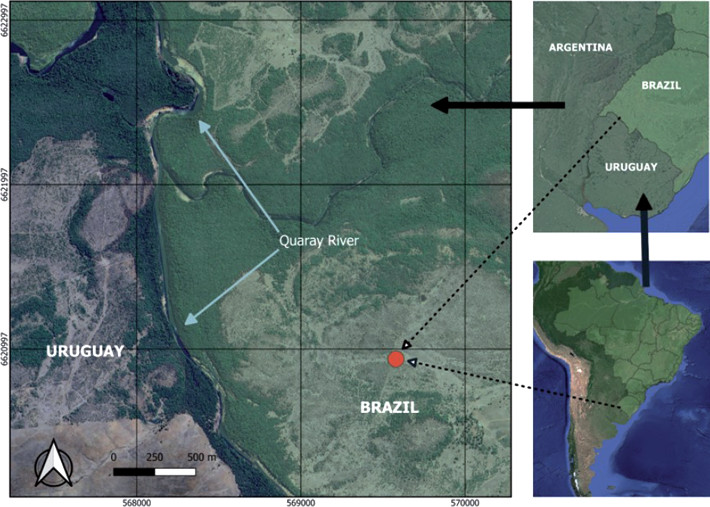First record of blackbuck Antilope cervicapra (Linnaeus, 1758) in Brazil
DOI:
https://doi.org/10.31687/SaremNMS24.11.7Keywords:
blackbuck, conservation, exotic species, Pampa biome, southern BrazilAbstract
This study is the first report of the exotic Blackbuck (Antilope cervicapra) in Brazil. The record was obtained through observation and videotape in a grassland area of Pampa Biome of the South region. The camera records are of female and juvenile individuals in an area adjacent to the riparian forest of the Quaraí River. In this region, there are also records of the exotic Chital deer (Axis axis), which underscore the necessity for studies of the impact of the presence of these species on the Brazilian Pampa ecosystem.
References
Chebez, J. C. 2008. Guía de mamíferos de América del Sur. Mastozoología Neotropical 15:155–157.
Chebez, J. C., & G. O. Rodríguez. 2014. La fauna gringa: especies introducidas en la Argentina. Fundación de Historia Natural Félix de Azara.
Isvaran, K. 2005a. Female grouping best predicts lekking in blackbuck (Antilope cervicapra). Behavioral Ecology and Sociobiology 57:283–294. http://doi.org/10.1007/s00265-004-0844-z.
Isvaran, K. 2005b. Variation in male mating behaviour within ungulate populations: patterns and processes. Current Science 89:1192–1199.
Isvaran, K. 2007. Intraspecific variation in group size in the blackbuck antelope: the roles of habitat structure and forage at different spatial scales. Oecologia 154(2):435–444. https://doi.org/10.1007/s00442-007-0840-x.
IUCN–SSC Antelope Specialist Group. 2017. Antilope cervicapra. The IUCN Red List of Threatened Species 2017:e.T1681A50181949. https://doi.org/10.2305/IUCN.UK.2017-2.RLTS.T1681A50181949.en.
Jarman, P. J. 1974. The social organization of antelope in relation to their ecology. Behaviour 48:215–267. https://doi.org/10.1163/156853974X00345.
Jha, R. R., & K. Isvaran. 2022. Antelope space-use and behavior indicate multilevel responses to varying anthropogenic influences in a highly human-dominated landscape. Ecology and Evolution 12:e9372. https://doi.org/10.1002/ece3.9372.
Jhala, Y. V. 1997. Seasonal effects on the nutritional ecology of blackbuck Antelope cervicapra. Journal of Applied Ecology 34:1348–1358. https://doi.org/10.2307/2405252.
Lever, C. 1985. Naturalized mammals of the world. Longman Science & Technology, London.
Medellin, R. A., H. Gómez, J. Álvarez, & A. Oliveras. 2005. Vertebrados superiores exóticos en México: diversidad, distribución y efectos potenciales. Instituto de Ecología, UNAM. Bases de datos SNIB–CONABIO. Proyecto U 20. https://doi.org/10.13140/RG.2.1.1820.6163.
Mertins, J. W., J. L. Schlater, & J. L. Corn. 1992. Ectoparasites of the blackbuck antelope (Antilope cervicapra). Journal of Wildlife Diseases 28(3):481–484. https://doi.org/10.7589/0090-3558-28.3.481.
Navas, J. 1987. Los vertebrados exóticos introducidos en la Argentina. Revista del Museo Argentino de Ciencias Naturales “Bernardino Rivadavia”, Zoología XIV:7–38.
Novillo, A., & R. A. Ojeda. 2008. The exotic mammals of Argentina. Biological Invasions 10:1333–1344. https://doi.org/10.1007/s10530-007-9208-8.
Ranjitsinh, M. K. 1989. Indian blackbuck. Nataraj Publishers, Dehradun.
Sánchez, C. 2015. Potencial impacto y de control del antílope negro (Antilope cervicapra), en un sitio de distribución exótica, La Pampa, Argentina. Tesis de Grado. Facultad de Ciencias Exactas y Naturales, Universidad Nacional de La Pampa, Santa Rosa, Argentina. <https://repo.unlpam.edu.ar/handle/unlpam/2254>.
Traweek, M. S. 1989. Statewide census of exotic big game animals. Federal Aid Project W-109-H-12, Job Number 21. Texas Parks and Wildlife Department, Austin, Texas.
Vats, R., & C. Bhardwaj. 2009. A study of reproductive behaviour of Indian black buck (Antilope cervicapra) Linn. with reference to courtship, breeding, fawning and colouration. Current World Environment 4:121–125.
Wilson, D. E., & D. M. Reeder. 2005. Mammal species of the world: a taxonomic and geographic reference. Johns Hopkins University Press, Baltimore.

Published
How to Cite
Issue
Section
License
Copyright (c) 2024 Paulo G. C. Wagner, Laura Berger, Fábio Dias Mazim, Walter Nisa-Castro-Neto

This work is licensed under a Creative Commons Attribution-NonCommercial 4.0 International License.

